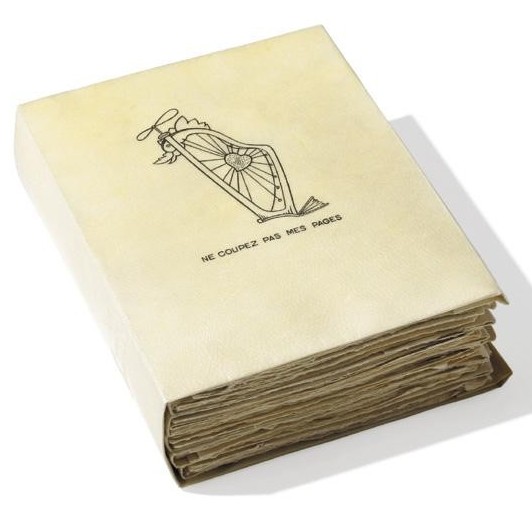391, 1-19 (1917-1924) [French]
Filed under artist publishing, magazine | Tags: · art, avant-garde, dada, poetry

391 was a Dada magazine edited by Francis Picabia and published between 1917 and 1924 in 19 numbers in Barcelona (nos. 1-4), New York (nos. 5-7), Zürich (no. 8) and Paris (nos. 9-19).
Contributors included Guillaume Apollinaire, Louis Aragon, Walter C. Arensberg, Céline Arnauld, Hans Arp, Pierre Albert-Birot, André Breton, Gabrielle Buffet, Jean Cocteau, Jean Crotti, Robert Desnos, Paul Dermée, Paul Éluard, Albert Gleizes, M. Goth, Max Jacob, M. Laurencin, René Magritte, Pierre de Massot, E.L.T. Mesens, Francis Picabia, Man Ray, Georges Ribemont-Dessaignes, Erik Satie, Walter Serner, Philippe Soupault, Tristan Tzara, Edgard Varèse, Marius de Zayas, a.o.
The issue 12 features Francis Picabia’s “Manifeste Dada” with reproduction of Marcel Duchamp’s L.H.O.O.Q.
Edited and published by Francis Picabia, Barcelona/New York/Zürich/Paris, January 1917-October 1924
Comment (0)Iliazd (ed.): Poésie de mots inconnus (1949)
Filed under artist publishing, poetry | Tags: · avant-garde, dada, poetry, sound poetry, visual poetry

An early anthology of experimental visual and sound poetry featuring poems by 21 avant-garde authors and illustrated with seven woodcuts, six etchings, two engravings, three drypoints, two aquatints, and six lithographs.
“Iliazd was well acquainted with the work of James Joyce, of Christian Morgenstern, and other writers who had played with the phonetic and graphical potential of language in the 19th and 20th century. But he chose to focus on the work of his peers, those figures within the modern movement of the first decades of the 20th century with whom he had been acquainted, and whose experiments he wished to bring to light and into a formal platform for recognition. He had good reason, in the late 1940s in Paris, to want to do this, as a gauntlet thrown down by the newly arrived upstart poet-theorist of Lettrism, Isidore Isou, challenged the emerging history of avant-garde literature with claims about the originality of his inventions.” (Source)
Poems by Ibronke Akinsemoyin, Pierre Albert-Birot, Hans Arp, Artaud, Jacques Audiberti, Hugo Ball, Nicolas Beaudin, Camille Bryen, Paul Dermée, Raoul Hausmann, Vincente Huidobro, Iliazd, Eugène Jolas, Velimir Khlebnikov, Alexei Krutchonykh, Pablo Picasso, Boris Poplavsky, Kurt Schwitters, Michel Seuphor, Igor Terentiev, Tristan Tzara.
Images by Arp, Georges Braque, Bryen, Marc Chagall, Oscar Dominguez, Serge Férat, Alberto Giacometti, Albert Gleizes, Hausmann, Henri Laurens, Alberto Magnelli, André Masson, Henri Matisse, Jean Metzinger, Joan Miró, Picasso, Léopold Survage, Sophie Taueber-Arp, Edgard Tytgatt, Wols, Ribemont-Dessaignes.
Publisher Le Degré Quarante et Un (Iliazd), Paris, 1949
26 folded sheets, 32 x 25 cm
Edition of 157
via MoMA
Commentary: Johanna Drucker (Amodern, 2016).
Comment (0)Roman Jakobson: My Futurist Years (1992/1997)
Filed under book | Tags: · 1910s, 1920s, biography, dada, formalism, futurism, language, linguistics, literary theory, literature, poetics, poetry, slavic studies

“Born in Moscow in 1896, Roman Jakobson was a founder of and a key figure in two influential schools of 20th century literary thought: Russian formalism, and later, during his years in Prague, structuralism. Forced to flee the invading Nazis, Jakobson spent time in Denmark, Norway, and Sweden, before coming to the United States in 1941. During his long and illustrious academic career in the U.S., Jakobson was a professor of literature and linguistics at Columbia, Harvard and MIT. Up to his death in 1982, he published 500 monographs and articles on linguistics, Slavic studies, poetics, and semiotics.
Vital as the extraordinary innovative and turbulent period that spawned these writings, My Futurist Years is one of the most important reflections on the Russian Futurist movement and a cornerstone in the career of one of the century’s greatest linguistic and literary thinkers.
Jakobson’s rare sensibility in his explorations in language and art are no more evident than in this volume, detailing the formative moment in his public and personal life. Along with the quite moving recollections of his friendships with such Modernist figures as Mayakovsky, Khlebnikov, and Malevich, the book includes Jakobson’s letters to other Futurists active in the scene and to his close friend Elsa Brik, later to gain notoriety as the French writer Elsa Triolet and wife of the poet Louis Aragon.” (from the back cover)
First published in Russian as Jakobson-budetljanin: sbornik materialov, Almqvist & Wiksell International, Stockholm, 1992.
Compiled and Edited by Bengt Jangfeldt
Translated and with an Introduction by Stephen Rudy
Publisher Marsilio, New York, 1997
ISBN 0941419797
371 pages
in the Unlimited Edition
Review: Avril Pyman (Slavonic & East European Review, 1993).
PDF (21 MB, updated on 2019-9-27)
Comment (0)
